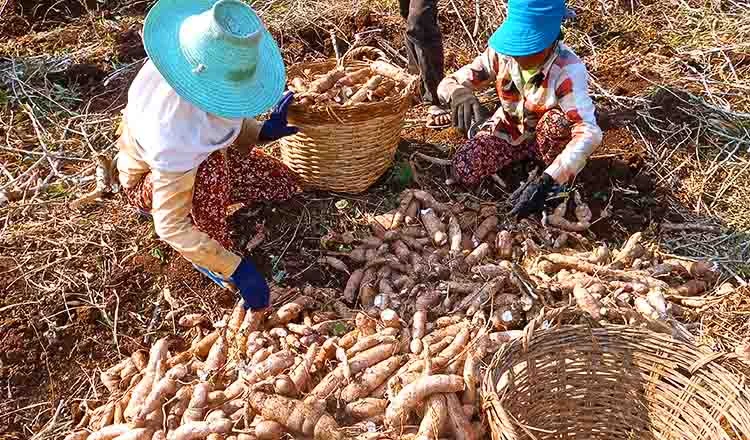High food prices in recent years have prompted farmers around the world to grow more grains and oilseeds. However, consumers will face tighter supplies in 2024, amid adverse El Nino weather, export restrictions and higher demand for biofuel production.
After years of strong increases, wheat, corn and soybean prices are on track to fall in 2023 as Black Sea congestion and concerns about a global recession ease. However, traders and analysts say that prices of these commodities remain vulnerable to supply shocks and food inflation in the new year.

Farmer harvesting cassava
“The grain supply picture certainly improves in 2023 with a stronger harvest in a key region. But we are still not really out of trouble,” said Ole Houe, director of consulting services at agricultural brokerage company IKON Commodities in Sydney.
He said that with the El Nino weather phenomenon expected to last at least until April or May 2024, Brazil will almost certainly produce less corn. He noted that China is surprising the market by purchasing large volumes of wheat and corn from the international market.
El Nino, which has caused drought in much of Asia this year, is forecast to continue into the first half of 2024, posing risks to supplies of rice, wheat, palm oil and other agricultural products in some parts of the world. The world’s leading agricultural exporter and importer. Traders predict Asia’s rice output in the first half of 2024 will fall as dry growing conditions and depleted reservoirs are likely to reduce output.
World rice supply tightened this year after the El Nino weather phenomenon reduced output, causing India, the world’s largest exporter, to limit exports. While other grain markets lost value, rice prices rose to a 15-year high in 2023, with rice prices in some export hubs in Asia rising 40-45%.
“When India restricted rice exports, Thailand and Vietnam took a large share of the global market. This will make commercial rice prices sensitive to weather conditions in both markets,” said BMI, a research unit of Fitch Solutions.
India’s next wheat crop is also at risk due to lack of moisture. This could force the world’s second-largest wheat consumer to seek imports for the first time in six years as wheat inventories in state stockpiles fall to their lowest level in seven years.
By April, farmers in Australia, the world’s second-biggest wheat exporter, will be able to plant new crops in parched fields, after intense heat limited this year’s crop yields. . That will likely push importing countries including China and Indonesia, to seek larger volumes of wheat from other exporters in North America, Europe and the Black Sea region.
“The wheat supply situation in the current 2023-2024 crop year is likely to worsen compared to the previous crop year. This is because exports from major wheat producing countries could be significantly lower,” Commerzbank said in a report.
On the positive side, corn, wheat and soybean production in South America is expected to improve in 2024, although erratic weather in Brazil has caused some skepticism. In Argentina, one of the world’s largest grain exporters, abundant rain in agricultural heartlands is likely to boost production of soybeans, corn and wheat.
According to Argentina’s Rosario grain exchange (BCR), 95% of corn and 75% of early planted soybeans are in “good to excellent” condition thanks to significant rainfall since late October across the country’s Pampas region. This. Brazil is expected to reach near-record agricultural output in 2024, although estimates for the country’s soybean and corn production have been cut in recent weeks due to dry weather.
Global palm oil production is also likely to decline next year due to dry El Nino weather, supporting the cooking oil market after the commodity dropped in price by more than 10% in 2023. Palm oil production dropped in context that demand for biodiesel production and cooking oil made from palm oil is expected to increase higher.
“In the coming year, we realize that food prices have more risk of increasing than decreasing. Global grain and oilseed stocks are tightening. The northern hemisphere may experience strong El Nino weather for the first time in the growing season since 2015,” said CoBank, a leading lending bank in the US agricultural sector.
